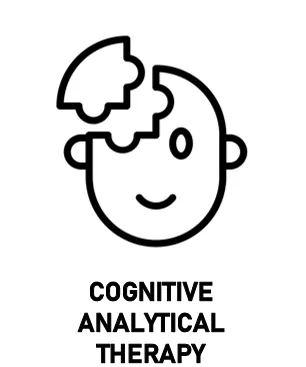Cognitive Analytical Therapy (CAT) is a type of talking therapy that can be used in the treatment of mental health conditions.
While CAT is not as well-known as its brother Cognitive Behavioural Therapy (CBT) – it still has the potential to be useful, and has helped many people.
CAT is a type of therapy that is typically short in length. The aim is for the therapist and patient to identify certain sequences that cause harm – and look to break this sequence in a positive manner.

The Science Behind Cognitive Analytical Therapy
The idea behind CAT is rather simple. As mentioned above, a focus is on disrupting harmful sequences that are damaging the mental health of the patient.
These sequences are typically made up of thoughts, behaviours, feelings and emotions – each of which can be caused by a variety of factors. Then, these areas result in a problem – for instance loneliness, self-harm or suicidal feelings.
A key idea too is for the therapist and patient to focus on problems between people, rather than deciding that the problems are within the patient – and exclusive to them.
This type of therapy was initially developed by Doctor Anthony Ryle, who created CAT for use in the United Kingdom’s National Health Service (NHS) [1]. He used the principles of CBT to form his own type of therapy.
CAT brings together both cognitive and analytical thinking. Ways of improving thought processes and behaviours are looked at, with changes hopefully implemented.
How Does Cognitive Analytical Therapy Work?
CAT is a type of therapy that is intended to be rather short in duration – typically 6-12 hours in total. The exact format would be agreed with the therapist.
To begin with, there will be a chance for the patient to have an open discussion with their therapist – which will help the therapist to get an idea of the difficulties facing the patient. This is known as the “reformulation” phase.
Damaging sequences, and their causes will be looked at. The patient is encouraged to recognise the issues they are facing and the impact they are having – all part of the “recognition” phase.
Then, the “revision” phase takes place, where an effort is made to try and disrupt these sequences. Practical ideas will be put forward as to different ways of thinking. The therapist will use a range of techniques to do this.
The patient will normally be encouraged to keep a thought diary of their thinking patterns between sessions. It is crucial for the patient and therapist to have a close relationship.
CAT involves a rather unique way of finishing therapy – involving “goodbye letters”. These letters summarise the achievements in therapy and goals for the future. It is recommended that a follow-up session is held a few months after the initial end of therapy – as it will give the patient a chance to review their progress.
When is Cognitive Analytical Therapy Useful?
While most people who are interested in a cognitive-based therapy will go for Cognitive Behavioural Therapy – there are several criticisms of CBT which make it unsuitable for many.
The good thing about CAT is that it involves both cognitive and analytical elements to it. Therefore, anyone that wants a mixture of cognitive and analytical themes may find CAT useful.
Particular conditions that may derive benefit from CAT includes Depression, Anxiety and sometimes, trauma-related conditions. Patients with Obsessive Compulsive Disorder (OCD) may also see an improvement in their symptoms.
The good thing about CAT is that it can be used at any time. If a patient hasn’t found relief from other therapies, they could turn to CAT. Alternatively, it also has the potential to be a good first line of treatment.
It is important to remember though that there is no such thing as a one-size-fits-all therapy.
How effective is Cognitive Analytical Therapy?
The evidence base for CAT is very positive. Due to its position as a relatively new type of therapy, it doesn’t have studies that look at the long-term impact of the therapy.
The biggest study into CAT’s effectiveness looked at 11 studies of CAT over a 30 year period [2]. The study found that out of the collective 324 participants in the studies – a strong increase in mental health was found [2].
CAT has also been used in the treatment of those with common conditions like Depression – with positive results [3].
CAT is being increasingly trialled in the treatment of Personality Disorders. Those with disorders like Borderline Personality Disorder and Histrionic Personality Disorder appear to be positively impacted by CAT [4].
CAT has also showed promise in treating conditions like OCD and Anxiety. Studies into CAT’s effect on trauma-based conditions is mixed.
How to find a therapist?
It is recommended that you contact your GP and inform them of your problems. They will refer you to the relevant mental health team.
If you are aiming to use the private sector, you could ask your GP or someone you know for a recommendation. You can also look online – the British Association for Counselling and Psychotherapy have a therapist directory on their site.
See Also
- Therapy Home
- Everything You Need To Know About Talking Therapy
- FAQ’s About Talking Therapy
- Cognitive Analytical Therapy: Everything You Need to Know
- The Advantages and Disadvantages of Cognitive Analytical Therapy
- 8 Things You Should Know About Cognitive Analytical Therapy
- What is the Difference Between Cognitive Behavioural Therapy and Cognitive Analytical Therapy?
Disclaimer
This website should be used purely for informational purposes, and does not intend to, nor should it ever, be used as a replacement for professional medical advice.
We strive to keep all of our pages updated, and ensure that our website is full of factual and in-depth information. However, we encourage you to browse this website with care.
As a reminder, this website and all content within it cannot and should not replace the advice of a trained medical professional. You can read our full disclaimer at this link.
Helplines
If you are struggling with your mental health, help is available. With the right support and treatment, you can make a recovery. For information on helplines, or if you are in a state of crisis, please visit our crisis page by clicking on the relevant link for your geographical location (United Kingdom), (United States), (International). You can also see how to get mental health treatment and the process involved by clicking this link.
References
[1] Ryle, A. (1990). Cognitive Analytic Therapy: Active Participation in Change. Chichester: John Wiley & Sons.
[2] Ryle, A., Kellett, S., Hepple, J., & Calvert, R. (2014). Cognitive analytic therapy at 30. Advances in Psychiatric Treatment. 20 (4): p258-268.
[3] Dunn, M., Golynkina, K., Ryle, A., & Watson, J. P. (1997). A repeat audit of the Cognitive Analytic Therapy Clinic at Guy’s Hospital. Psychiatric Bulletin. 21 (3): p165–168.
[4] Clarke, S., Thomas, P., & James, K. (2013). Cognitive analytic therapy for personality disorder: randomised controlled trial. The British Journal of Psychiatry. 202 (2): p129-134.




























